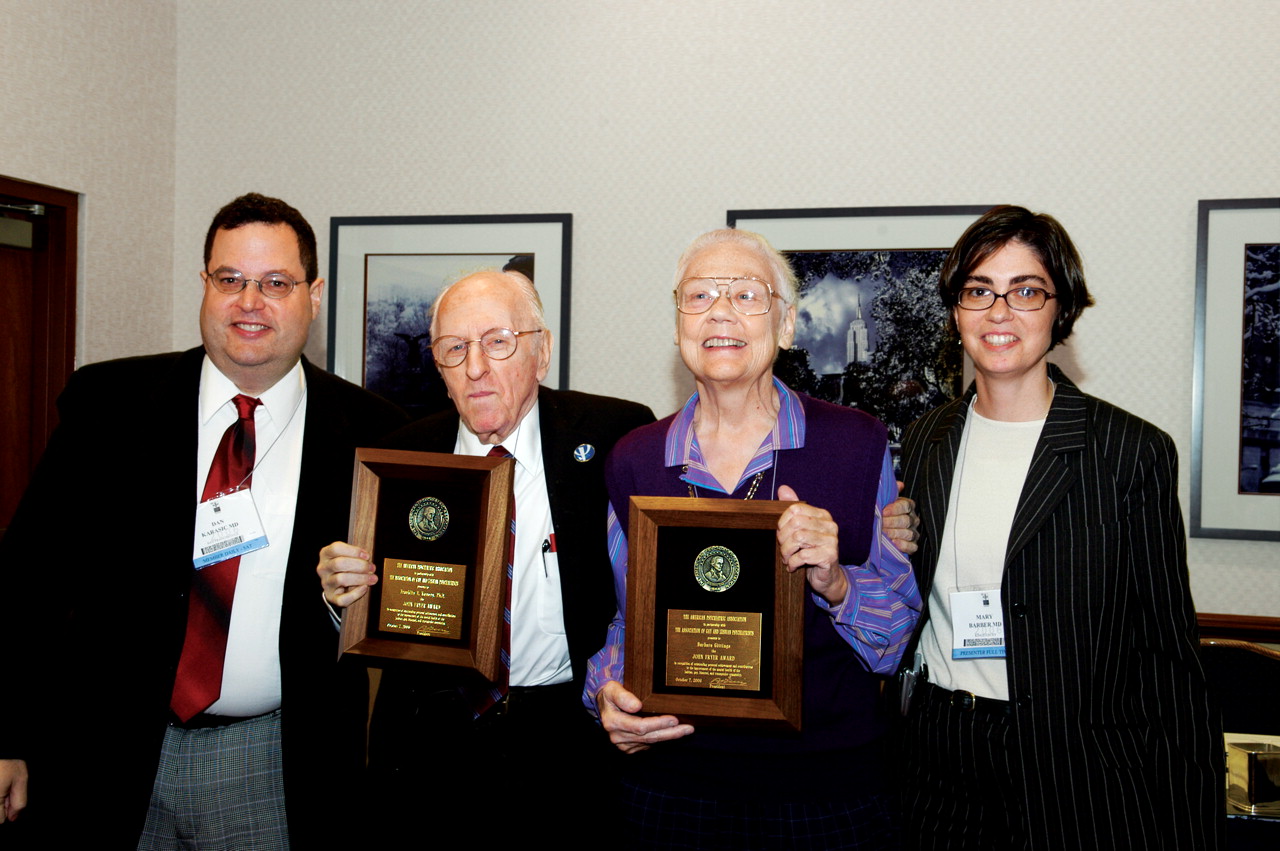Activists Forced Psychiatrists To Look Behind Closet Door

Frank Kameny, Ph.D. (second from left), and Barbara Gittings (third from left) were honored last month at APA's Institute on Psychiatric Services as the recipients of the first APA John E. Fryer, M.D., Award. Presenting the award were Dan Karasic, M.D., and Mary Barber, M.D., of the Association of Gay and Lesbian Psychiatrists, which co-sponsors the award. Ellen Dallager
Frank Kameny, Ph.D., and Barbara Gittings were honored last month at APA's Institute on Psychiatric Services for their work as pioneers in the gay-rights movement. They were presented with the first APA John E. Fryer, M.D., Award.
Fryer was a gay psychiatrist who appeared at APA's 1972 annual meeting in Dallas wearing a wig and a mask to shield his identity. He was introduced as Dr. H. (for homosexual) Anonymous at a panel discussion titled“ Psychiatry: Friend or Foe to Homosexuals: A Dialogue.” The public appearance of a gay psychiatrist explaining at an APA meeting why he could not be open within his profession helped to galvanize a group of largely closeted gay psychiatrists within APA at a time when homosexuality was still widely viewed as pathological by psychiatrists and others.
The following year homosexuality was removed from the list of disorders in DSM.
Kameny and Gittings were prominent in the movement that led to that removal. Gittings has been a gay-rights activist since 1958, when she started the New York chapter of the lesbian organization Daughters of Bilitis. In 1965 she marched in the first gay pickets at the White House and Independence Hall in Philadelphia calling for an end to discrimination against gay people.
Kameny has been at the forefront of gay civil rights for more than four decades. As a self-styled paralegal, he served as personal representative in cases involving military, civil service, and security clearances. He was instrumental in helping to pass Washington, D.C.'s Human Rights Law in 1973, one of the nation's first laws to ban discrimination against gay people.
In a lecture they presented last month, titled “Gay, Proud, and Healthy: From Heresy to Humdrum,” Gittings and Kameny spoke informally about the earliest days of the gay-rights movement.
“At the time the movement was bland and apologetic and deferential to authority,” Kameny recalled. “That wasn't my style. I wanted us to take the position for the first time that we gays are the sole authority on our lives.”
It was Kameny who coined the phrase “gay is good” as a way of affirming a positive identity for gay people, rather than one that was defensive and deferential.
Kameny and Gittings also recounted the fateful appearance of Dr. H. Anonymous at the 1972 meeting and the events leading up to that appearance.
“Frank and I were invited to be on a panel in Dallas called `Psychiatry: Friend or Foe to Homosexuals: A Dialogue,'” Gittings recalled. “My partner, Kay, said, `This isn't right—here you have two psychiatrists pitted against two gays, and what you really need is someone who is both.' The panel moderator, Dr. Kent Robinson, agreed to add a gay psychiatrist if we could find one. In 1972 who would come forward?... Kay and I wrote letters and made phone calls around the country.
“At last, John Fryer said yes, provided he could wear a wig and mask and use a voice-distorting microphone,” Gittings said. “Dr. H. Anonymous was born. We smuggled him in his disguise through back corridors into the packed lecture hall. He really rocked the audience, speaking as a closeted gay person to his own colleagues, telling why he couldn't be open in his own profession. To back up John Fryer, I read excerpts from letters I'd solicited from the other gay psychiatrists who felt they had to decline to be on the panel.”
Gittings displayed photographs of significant events in gay-rights history, including pictures of Fryer in his mask—a distorted and grotesque disguise—as he was seated at the panel. Both Gittings and Kameny said the event was transformative.
“By drawing attention to the mask and the damage it does, Dr. H. Anonymous helped tear away disguise and secrecy,” Gittings said.“ He gave courage to his fellow gay and lesbian psychiatrists to be fully themselves and to affirm, in Frank's great motto, that Gay Is Good.
“The gay community's mental health improved dramatically when we spoke up for ourselves and took charge of our own destiny. I'm so glad I was a player in this part of gay history and that I got to know the incomparable John Fryer.” ▪



